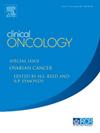结转移体积对宫颈癌和腹主动脉旁淋巴结转移患者远端转移的影响
IF 3
3区 医学
Q2 ONCOLOGY
引用次数: 0
摘要
目的报道宫颈癌伴主动脉旁淋巴结(PAN)转移的最终放射治疗(RT)后的机构结局,探讨继发远处转移(DM)的危险因素和最佳选择放射场。材料与方法对2011 - 2023年间收治的97例患者进行评价。患者中位年龄为60岁(范围29-86岁)。FIGO 2008期I、II、III、IVA患者分别为6例(6%)、32例(33%)、43例(44%)、16例(16%)。82例为鳞状细胞癌。原发(GTVp)和淋巴结转移(GTVn)的中位总肿瘤体积分别为110.4 (20.6-340.7)cm3和15.3 (1.0-120.6)cm3。GTVn/GTVp比值中位数为12.8%。在68%的队列中,累及淋巴结以上的选择性PAN野缘为1个椎体高度或更小。在52例和45例患者中,分别采用常规三维适形放疗和调强放疗进行扩展视场放疗。转移区和选择性区的中位辐射剂量分别为56 Gy和50 Gy。90例(93%)患者同时接受化疗。结果中位随访34个月(范围4 ~ 143个月),3年野外无复发生存率为74%,无dm生存率为51%,总生存率为66%。GTVn/GTVp比值较高的患者发生糖尿病的风险明显高于对照组。只有2例(2%)患者在放疗区外出现孤立性PAN复发。结论sdm是最常见的复发方式,GTVn/GTVp比值越高,sdm复发风险越高。在受累的PAN上方有足够的切缘可能并不一定需要实现骨盆和PAN的疾病控制。本文章由计算机程序翻译,如有差异,请以英文原文为准。
Impact of Nodal Metastatic Volume on Distant Metastasis in Patients with Cervical Cancer and Para-aortic Nodal Metastases Treated With Definitive Radiation Therapy
Aims
To report institutional outcomes following definitive radiation therapy (RT) for cervical cancer with para-aortic lymph node (PAN) metastasis and explore the risk factors for subsequent distant metastasis (DM) and the optimal elective radiation field.
Material and Methods
Ninety-seven patients treated between 2011 and 2023 were evaluated. The median patient age was 60 (range, 29–86) years. The numbers of patients with International Federation of Gynecology and Obstetrics (FIGO) 2008 stages I, II, III, and IVA were 6 (6%), 32 (33%), 43 (44%), and 16 (16%), respectively. Eighty-two patients had squamous cell carcinoma. The median gross tumor volumes of primary (GTVp) and nodal metastasis (GTVn) were 110.4 (range, 20.6–340.7) cm3 and 15.3 (range, 1.0–120.6) cm3, respectively. The median GTVn/GTVp ratio was 12.8%. The elective PAN field margin above the involved node was one vertebral height or less in 68% of the cohort. Extended-field RT was delivered using conventional three-dimensional conformal RT and intensity-modulated RT in 52 and 45 patients, respectively. The median radiation doses to the metastatic and elective regions were 56 and 50 Gy, respectively. Concurrent chemotherapy was administered to 90 (93%) patients.
Results
With a median follow-up of 34 (range, 4–143) months, the 3-year in-field recurrence-free survival, DM-free survival, and overall survival rates were 74%, 51%, and 66%, respectively. Patients with a higher GTVn/GTVp ratio had a significantly higher risk of developing DM than their counterparts. Only two (2%) patients developed isolated PAN recurrence outside the irradiated field.
Conclusions
DM is the most common mode of recurrence, the risk of which is significantly higher in patients with higher GTVn/GTVp ratios. An ample margin above the involved PAN may not necessarily be required to achieve disease control in the pelvis and PAN.
求助全文
通过发布文献求助,成功后即可免费获取论文全文。
去求助
来源期刊

Clinical oncology
医学-肿瘤学
CiteScore
5.20
自引率
8.80%
发文量
332
审稿时长
40 days
期刊介绍:
Clinical Oncology is an International cancer journal covering all aspects of the clinical management of cancer patients, reflecting a multidisciplinary approach to therapy. Papers, editorials and reviews are published on all types of malignant disease embracing, pathology, diagnosis and treatment, including radiotherapy, chemotherapy, surgery, combined modality treatment and palliative care. Research and review papers covering epidemiology, radiobiology, radiation physics, tumour biology, and immunology are also published, together with letters to the editor, case reports and book reviews.
 求助内容:
求助内容: 应助结果提醒方式:
应助结果提醒方式:


